Posted on April 6th, 2018 by Mary Lord
 A diving trip in Greece drove a Dutch teen named Boyan Slat to spend the next 10 years devising a way to clean up ocean plastic. His giant boom is set to launch in the Great Pacific Garbage Patch this year. Other eco-activists have developed trash-intercepting water wheels and campaigns to reduce the use of plastic drinking straws.
A diving trip in Greece drove a Dutch teen named Boyan Slat to spend the next 10 years devising a way to clean up ocean plastic. His giant boom is set to launch in the Great Pacific Garbage Patch this year. Other eco-activists have developed trash-intercepting water wheels and campaigns to reduce the use of plastic drinking straws.
Read More
Filed under: Special Features | Comments Off on Meet the Ocean Cleanup Crew
Tags: Boyan Slat, clean up, Environmental Engineering, Great Pacific Garbage Patch, marine debris, Mr. Trash Wheel, Ocean Cleanup, ocean plastic, One Less Straw, Technology, US Fish and Wildlife Service, USFWS Pacific
Posted on April 6th, 2018 by Mary Lord
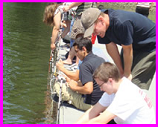 Sensors are in everything from smart phones to corn fields. They also can be a powerful and engaging tool to teach STEM. SENSE IT, a free, research-based curriculum, involves students in hands-on learning about their local environment by constructing, deploying, and interpreting data from a network of water-quality sensors.
Sensors are in everything from smart phones to corn fields. They also can be a powerful and engaging tool to teach STEM. SENSE IT, a free, research-based curriculum, involves students in hands-on learning about their local environment by constructing, deploying, and interpreting data from a network of water-quality sensors.
Read More
Filed under: Grades 6-8, Grades 9-12, K-12 Outreach Programs, Lesson Plans, Web Resources | Comments Off on Sense It!
Tags: circuits, Curriculum, data analysis, Environmental Engineering, Environmental science, Grades 6-8, Grades 9-12, integrated STEM, Internet Resources, iSTEM, Lesson Plan, Liesl Hotaling, SENSE IT, sensors, Teacher Resources, water quality, Web Resources
Posted on April 6th, 2018 by Mary Lord
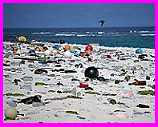 Students learn about the Great Pacific garbage patch, research the extent and impact of plastics pollution on oceans, and present that information as a short, eye-catching newsletter suitable to hand out to fast-food restaurant customers.
Students learn about the Great Pacific garbage patch, research the extent and impact of plastics pollution on oceans, and present that information as a short, eye-catching newsletter suitable to hand out to fast-food restaurant customers.
Read More
Filed under: Class Activities, Grades 6-8, Lesson Plans | Comments Off on Ahoy! Plastic in the Ocean
Tags: Class Activities, Common Core State Standards, data analysis, ecosystem, Environmental Engineering, environmental stewardship, GIS, Grades 6-8, graphic design, great ocean garbage dump, Lesson Plan, literacy, Mapping, Marine Science, Pollution, Research, STEAM, Videos, water cycle, writing
Posted on February 8th, 2018 by Mary Lord
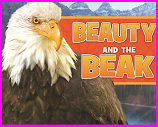 Children’s literature is full of memorable wildlife adventure stories, but Deborah Lee Rose and Jane Veltkamp’s Beauty and the Beak may be the first to feature engineers and their role in outfitting an injured eagle with a 3-D printed prosthetic beak. A free education guide with standards-based STEM, STEAM, and literacy lessons accompanies the book, winner of the 2018 AAAS/Subaru SB&F Prize for Excellence in Science Books.
Children’s literature is full of memorable wildlife adventure stories, but Deborah Lee Rose and Jane Veltkamp’s Beauty and the Beak may be the first to feature engineers and their role in outfitting an injured eagle with a 3-D printed prosthetic beak. A free education guide with standards-based STEM, STEAM, and literacy lessons accompanies the book, winner of the 2018 AAAS/Subaru SB&F Prize for Excellence in Science Books.
Read More
Filed under: Class Activities, For Teachers, Special Features, Web Resources | Comments Off on Injured Eagle Lands New Beak
Tags: 3-D printing, AAAS/Suburu best science books, bald eagle rescue, Beauty and the Beak, biologyy, Birds of Prey Northwest, children's literature, Class Activities, Deborah Lee Rose, eagle, Engineering, Environmental Engineering, Environmental science, Internet Resources, Jane Veltkamp, Prosthetics, raptor, Resources for Teachers, STEM education, wildlife, wildlife engineering, wildlife rescue
Posted on January 5th, 2018 by Mary Lord
 Introduce a girl to engineering. Make slime and other cool stuff. Visit a local engineering school. National Engineers Week kicks off on Feb. 18 2018 and this year’s theme – Engineers: Inspiring Wonder – offers an opportunity to learn about how engineers make a difference in our world. How will you celebrate?!
Introduce a girl to engineering. Make slime and other cool stuff. Visit a local engineering school. National Engineers Week kicks off on Feb. 18 2018 and this year’s theme – Engineers: Inspiring Wonder – offers an opportunity to learn about how engineers make a difference in our world. How will you celebrate?!
Read More
Filed under: K-12 Outreach Programs, Special Features | Comments Off on Engineers Week 2018
Tags: Civil Engineering, Class Activities, DiscoverE, Engineering is Elementary, Engineers Week, Environmental Engineering, Internet Resources, Resources for Teachers, STEM education, Web Resources
Posted on December 10th, 2017 by Mary Lord
 “It started out as a beautiful day, but in a disaster, anything can happen at any time…” So begins Extreme Event, a free, hour-long role-playing game from the National Academy of Sciences’ Marian Koshland Science Museum. The game is latest addition to teacher resources designed to help students and communities use science to address climate change, health, and other problems.
“It started out as a beautiful day, but in a disaster, anything can happen at any time…” So begins Extreme Event, a free, hour-long role-playing game from the National Academy of Sciences’ Marian Koshland Science Museum. The game is latest addition to teacher resources designed to help students and communities use science to address climate change, health, and other problems.
Read More
Filed under: K-12 Outreach Programs, Special Features, Web Resources | Comments Off on Extreme Event: Free STEM Games
Tags: chlimate change, Class Activities, Environmental Engineering, Environmental science, game, Health, Internet Resources, Koshland Science Museum, National Academies of Sciences, natural disasters, Public Policy, Resources for Teachers, role playing, Web Resources
Posted on September 28th, 2017 by Mary Lord
 After Hurricane Harvey inundated Houston with historic rains, engineering researchers Texas A&M University offered a quick, inexpensive way to survey the damage. They deployed drones – lots of them – in the biggest squadron ever used in an official disaster response.
After Hurricane Harvey inundated Houston with historic rains, engineering researchers Texas A&M University offered a quick, inexpensive way to survey the damage. They deployed drones – lots of them – in the biggest squadron ever used in an official disaster response.
Read More
Filed under: Special Features | Comments Off on Eyes in the Skies
Tags: Drones, engineering research, Environmental Engineering, hurricane, National Science Foundation, Robotics, Science, search and rescue, unmanned aerial systems, Videos
Posted on September 27th, 2017 by Mary Lord
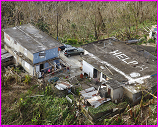 Hurricanes, earthquakes, and other destructive events offer timely “teachable moments” about the role of engineers in improving weather forecasts and reducing the toll from natural disasters. eGFI Teachers’s collection of activities, feature articles, and other resources can help you integrate engineering into your classes – and inspire the next generation of “crisis” engineers.
Hurricanes, earthquakes, and other destructive events offer timely “teachable moments” about the role of engineers in improving weather forecasts and reducing the toll from natural disasters. eGFI Teachers’s collection of activities, feature articles, and other resources can help you integrate engineering into your classes – and inspire the next generation of “crisis” engineers.
Read More
Filed under: Class Activities, Grades 6-8, Grades 6-8, Grades 9-12, Grades 9-12, Grades K-5, Grades K-5, Lesson Plans, Special Features | Comments Off on Disaster Engineering
Tags: Army Corps of Engineers, build, building, Class Activities, data, Disaster relief, drought, Engineering, Environmental Engineering, erosion, forces, hurricane, Hurricane Maria, measure, Mining, motion, National Guard, natural disasters, Physics, rescue, storm, Structural Engineering, Teacher Resources, Technology, tornado, Weather, Web Resources
Posted on August 10th, 2017 by Mary Lord
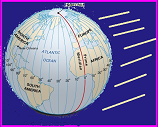 Middle school students learn about the Earth’s geometrical relation to the sun by calculating where the sun will be in the sky for any date or time given a particular location on Earth, such as their school. The three-activity module was developed by lighting engineer Tony Esposito, Ph.D., during his graduate studies at Pennsylvania State University and made available to eGFI Teachers.
Middle school students learn about the Earth’s geometrical relation to the sun by calculating where the sun will be in the sky for any date or time given a particular location on Earth, such as their school. The three-activity module was developed by lighting engineer Tony Esposito, Ph.D., during his graduate studies at Pennsylvania State University and made available to eGFI Teachers.
Read More
Filed under: Class Activities, Grades 6-8, Lesson Plans, Special Features | Comments Off on Solar Geometry
Tags: angle, calendar, Class Activities, day, earth sciences, eclipse, Environmental Engineering, Environmental science, Geometry, globe, Grades 6-8, latitude, Lesson Plans, light engineering, longitude, map, Mathematics, NASA, Project CANDLE, season, Solar Geometry, sun, Tony Esposito Jr.
 A diving trip in Greece drove a Dutch teen named Boyan Slat to spend the next 10 years devising a way to clean up ocean plastic. His giant boom is set to launch in the Great Pacific Garbage Patch this year. Other eco-activists have developed trash-intercepting water wheels and campaigns to reduce the use of plastic drinking straws.
A diving trip in Greece drove a Dutch teen named Boyan Slat to spend the next 10 years devising a way to clean up ocean plastic. His giant boom is set to launch in the Great Pacific Garbage Patch this year. Other eco-activists have developed trash-intercepting water wheels and campaigns to reduce the use of plastic drinking straws. 








 Sensors are in everything from smart phones to corn fields. They also can be a powerful and engaging tool to teach STEM. SENSE IT, a free, research-based curriculum, involves students in hands-on learning about their local environment by constructing, deploying, and interpreting data from a network of water-quality sensors.
Sensors are in everything from smart phones to corn fields. They also can be a powerful and engaging tool to teach STEM. SENSE IT, a free, research-based curriculum, involves students in hands-on learning about their local environment by constructing, deploying, and interpreting data from a network of water-quality sensors.  Students learn about the Great Pacific garbage patch, research the extent and impact of plastics pollution on oceans, and present that information as a short, eye-catching newsletter suitable to hand out to fast-food restaurant customers.
Students learn about the Great Pacific garbage patch, research the extent and impact of plastics pollution on oceans, and present that information as a short, eye-catching newsletter suitable to hand out to fast-food restaurant customers.  Children’s literature is full of memorable wildlife adventure stories, but Deborah Lee Rose and Jane Veltkamp’s Beauty and the Beak may be the first to feature engineers and their role in outfitting an injured eagle with a 3-D printed prosthetic beak. A free education guide with standards-based STEM, STEAM, and literacy lessons accompanies the book, winner of the 2018 AAAS/Subaru SB&F Prize for Excellence in Science Books.
Children’s literature is full of memorable wildlife adventure stories, but Deborah Lee Rose and Jane Veltkamp’s Beauty and the Beak may be the first to feature engineers and their role in outfitting an injured eagle with a 3-D printed prosthetic beak. A free education guide with standards-based STEM, STEAM, and literacy lessons accompanies the book, winner of the 2018 AAAS/Subaru SB&F Prize for Excellence in Science Books. Introduce a girl to engineering. Make slime and other cool stuff. Visit a local engineering school. National Engineers Week kicks off on Feb. 18 2018 and this year’s theme – Engineers: Inspiring Wonder – offers an opportunity to learn about how engineers make a difference in our world. How will you celebrate?!
Introduce a girl to engineering. Make slime and other cool stuff. Visit a local engineering school. National Engineers Week kicks off on Feb. 18 2018 and this year’s theme – Engineers: Inspiring Wonder – offers an opportunity to learn about how engineers make a difference in our world. How will you celebrate?! “It started out as a beautiful day, but in a disaster, anything can happen at any time…” So begins Extreme Event, a free, hour-long role-playing game from the National Academy of Sciences’ Marian Koshland Science Museum. The game is latest addition to teacher resources designed to help students and communities use science to address climate change, health, and other problems.
“It started out as a beautiful day, but in a disaster, anything can happen at any time…” So begins Extreme Event, a free, hour-long role-playing game from the National Academy of Sciences’ Marian Koshland Science Museum. The game is latest addition to teacher resources designed to help students and communities use science to address climate change, health, and other problems.  After Hurricane Harvey inundated Houston with historic rains, engineering researchers Texas A&M University offered a quick, inexpensive way to survey the damage. They deployed drones – lots of them – in the biggest squadron ever used in an official disaster response.
After Hurricane Harvey inundated Houston with historic rains, engineering researchers Texas A&M University offered a quick, inexpensive way to survey the damage. They deployed drones – lots of them – in the biggest squadron ever used in an official disaster response.  Hurricanes, earthquakes, and other destructive events offer timely “teachable moments” about the role of engineers in improving weather forecasts and reducing the toll from natural disasters. eGFI Teachers’s collection of activities, feature articles, and other resources can help you integrate engineering into your classes – and inspire the next generation of “crisis” engineers.
Hurricanes, earthquakes, and other destructive events offer timely “teachable moments” about the role of engineers in improving weather forecasts and reducing the toll from natural disasters. eGFI Teachers’s collection of activities, feature articles, and other resources can help you integrate engineering into your classes – and inspire the next generation of “crisis” engineers. Middle school students learn about the Earth’s geometrical relation to the sun by calculating where the sun will be in the sky for any date or time given a particular location on Earth, such as their school. The three-activity module was developed by lighting engineer Tony Esposito, Ph.D., during his graduate studies at Pennsylvania State University and made available to eGFI Teachers.
Middle school students learn about the Earth’s geometrical relation to the sun by calculating where the sun will be in the sky for any date or time given a particular location on Earth, such as their school. The three-activity module was developed by lighting engineer Tony Esposito, Ph.D., during his graduate studies at Pennsylvania State University and made available to eGFI Teachers.